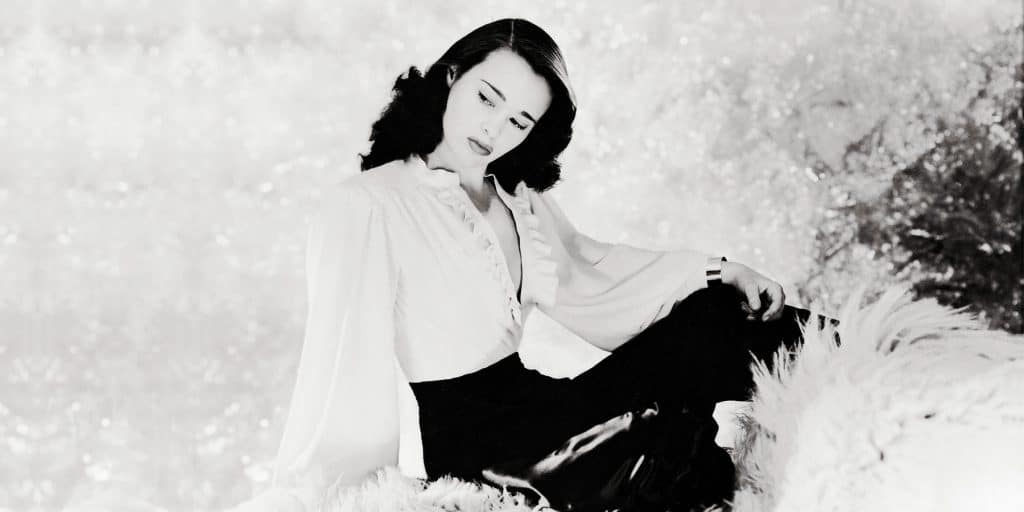
November 10, 2010Heiress, fashion icon, actress and artist Gloria Vanderbilt was captured by Francesco Scavullo in the living room of Summertime, her Southampton, Long Island, home wearing a dress by New York City Ballet’s famed costume designer Barbara Karinska. She is posed in front of her own collage of Queen Elizabeth. Top: Vanderbilt, photographed by George Hoyningen-Huene in the summer of 1941.
Say the name, and you can conjure the face: the high cheekbones and slanting eyes topped by the sleek helmet of black hair; the white, even teeth revealed in something too watchful to be called a smile. Gloria Vanderbilt — socialite, writer, muse, designer, artist, poor-little-rich-girl pawn in a multimillion-dollar custody battle — is one of the few people alive who actually deserves to be called an icon. And now, seemingly, she has her very own iconostasis: a gorgeous 220-page, large-format text-and-picture book written, with its subject’s full cooperation, by the journalist and editor Wendy Goodman and sumptuously designed by the legendary Chip Kidd. (There’s a foreword, too, from Vanderbilt’s son CNN’s Anderson Cooper.)

A young Vanderbilt is ushered through curious crowds during the custody trial between her mother and her paternal aunt Gertrude Vanderbilt Whitney. Photo courtesy of Gloria Vanderbilt
The World of Gloria Vanderbilt (Abrams) chronicles a life lived in the glare of photographers’ strobes and on the pages of tabloids or glossy magazines. So it’s appropriate that the book’s illustrations form a narrative at least as revealing as the prose between them. Here is the toddler Gloria in 1925, dwarfed by the facade of the Vanderbilts’ Newport mansion, the Breakers; there, the pudgy, anxious 10-year-old arriving outside the courthouse where her art-loving aunt Gertrude Vanderbilt Whitney and feckless widowed mother are fighting for custody of “little Gloria” and her fortune. Then, captured by the lenses of Horst and Hoyningen-Huene, Avedon and Scavullo, the awkward child is transformed into a beauty who attracts men like Howard Hughes, Errol Flynn, Marlon Brando and Frank Sinatra. Wearing a décolletée black dress that brings to mind Sargent’s Madame X and sitting next to her idol Rita Hayworth on a striped banquette at El Morocco, she looks as bedazzled by the turn in her fortunes as she is dazzling.

Actors Bruce Cabot and Rita Hayworth share a booth with Vanderbilt at the legendary Manhattan nightclub El Morocco. Photo by Photofest
Possibly searching for the family life she never had, she embarks on a string of marriages — to Pasquale “Pat” DiCicco, a card shark who beats her; the orchestra conductor Leopold Stokowski, 40 years her senior, who dominates her; the film director Sidney Lumet — before finding happiness with the writer Wyatt Cooper. She becomes a fixture of the Best Dressed List and a household name in Middle America, photographed amid the denim-clad posteriors of a bevy of models wearing her signature blue jeans. And she endures tragedy: Cooper’s early death from heart disease in 1978 and the suicide of their son Carter 10 years later.

In the early 1980s, Vanderbilt poses with three of her four sons — from left, Carter, Anderson and Stan — during the renovation of her penthouse at 10 Gracie Square. Photo by Cris Alexander
Through it all, Vanderbilt has the urge to create. She flirts with acting and writes memoirs, poetry and fiction. She designs stylish, offbeat interiors — a penthouse with black-and-white-tiled floors that, Goodman writes, has “the enchantment of a film set by the artist Christian Bérard”; a townhouse whose every surface is covered in patchwork; a gingham-swathed Stanford White Southampton “cottage” — that are the antitheses of the empty marble sarcophagi she grew up in.

The multitalented Vanderbilt, who once said that “decorating is an autobiography,” imbued a multitude of homes with her singular personality. Left: her large-scale collage painting The Necklace, 1968, dominates a living room tableau. Right: The pink and green mantel and the canvas above, both of which Vanderbilt painted, engage in a colorful conversation. Richard Avedon purchased the picture, which Vanderbilt’s son, CNN anchor Anderson Cooper, bought back at an auction following Avedon’s death. Photos by Ditte Isager

In addition to painting and designing interiors, Vanderbilt created stationery for Hallmark Cards and bed linens for Martex. She also served as design director for Riegel Textile Corp. Photo courtesy of Gloria Vanderbilt
She makes paintings: stylized canvases reminiscent of Marie Laurencin’s work, collages that look like Édouard Vuillard channeling Frida Kahlo and surreal oversized assemblages called Dream Boxes. And she transforms herself into an art object, posing beside her artwork in silver harem pants and toe rings or wearing the black boots and ribbons of a Spanish grandee.
It’s these poses, these paintings and interiors and the still lifes she creates, on tabletops or mantelpieces, out of beautiful and unexpected trinkets like old silver, vintage dolls’ heads or antique beads that mark her as more than a symbol of wealth and style, more than a celebrity with good taste. In The World of Gloria Vanderbilt you can see her taking life and rearranging it into a more pleasing or more interesting form, sometimes with herself at the center, sometimes — as in one of Avedon’s photographs — cropped out of the image entirely except for her pajama-clad legs, poised on a ladder that extends beyond the picture’s upper frame. Handed lemons on the silver tray that was her birthright, she has made lemonade from them — perhaps as good a definition of an artist as any other.



